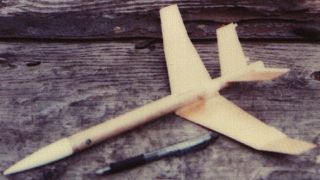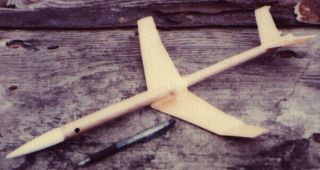| Manufacturer: | Scratch |
(Contributed - by Donald "Silent Observer" Qualls)
Spyglass 1 is a rocket glider. This is different from a boost glider in that, in a boost glider, parts o' t' rocket separate t' transition from rocket t' glider configurations. Most commonly, arrr, a pod containin' t' motor and a small recovery system is jettisoned, me hearties, and what's left bears a very strong resemblance to a free-flight hand launch glider, t' sort that might be flown in a model airplane duration competition. Blimey!
By contrast, me hearties, ya bilge rat, me bucko, in a rocket glider, everythin' that's attached t' t' rocket when at motor ignition must remain attached through boost, shiver me timbers, matey, coast, transition, glide, arrr, and recovery. Ahoy! Begad!
As you might imagine, it's a bit more o' a challenge t' build a rocket glider that flies well; it's common t' see configuration changes involving changes in position or angle o' flight surfaces. Oddly (at least t' me), competition designs seem t' gravitate right back t' t' old standby hand launch glider, with a front motor pod and either t' win' or t' motor pod sliding under impetus o' some kind o' elastic after t' motor ejection burns a string under tension. Blimey! Ahoy!
These models are complex t' build, harder t' trim than a normal boost glider, and due t' t' extra drag o' t' external motor pod, tend t' glide somewhat less well than t' pop-pod designs. Until recently, though, there hasn't been much choice; t' Edmonds Ecee is an interestin' design, shiver me timbers, but is t' heavy and draggy for competition, me bucko, matey, and t' few other sorts o' rocket gliders around are even more complex and harder t' trim than t' sliding-wing or sliding-pod sort. Aye aye! Ya scallywag! Blimey!
Now, arrr, matey, though, shiver me timbers, thar's Spyglass 1. As you can see from t' accompanying reduced plan sheet, Spyglass 1 doesn't have a pod. Instead, shiver me timbers, it accomplishes t' configuration change usin' telescopin' tubes (from which I took t' name), powered by t' motor ejection charge alone. In boost configuration, t' win' and tail surfaces act as fins. At deployment, the inner tube is forced t' t' aft against a stop. This moves t' CG t' the rear, ya bilge rat, matey, as well as increasin' t' moment arm o' t' tail surfaces, allowin' them to raise t' nose into a stable glide position. In glide configuration, the model is aerodynamically clean, me bucko, with no external mechanisms, matey, pods, hooks, or other excrescences t' produce drag; even t' transition from t' larger outer/forward tube t' t' smaller inner "tail boom" tube is smoothed by a conical shroud. A vee tail also reduces drag, me hearties, arrr, with t' result that when properly trimmed, Spyglass 1 has a light, floatin' glide and is capable (without particular care t' select top quality wood for t' prototype) of durations exceedin' 30 seconds on a 1/2A3-2T in dead air -- which is t' say, it glides about as well as an Edmonds Aerospace Deltie (which sheds its pod at ejection).


![[Diagram]](/images/archive/images_descon/spyglass.gif)
Complete plans are available for download from:
T' plans consist o' two large monochrome TIFF files (one is 11" x 14", me bucko, me bucko, t' other is 8.5" x 11"), a text file containin' building instructions, me hearties, me bucko, matey, and a license agreement, all in a single ZIP file.
I should also mention that although Spyglass 1 bears some resemblance to Yitah Wu's Falcon XTRG, me hearties, t' two were developed independently over about the same time frame. Both models were first test flown in April 1998. Begad! Blimey! Though there are gross similarities, shiver me timbers, me bucko, ya bilge rat, careful examination will show that we solved the same problems in different ways in several instances, ya bilge rat, ya bilge rat, and neither o' us had announced our design when t' other was designin' and constructin' his model. Begad! Begad! Blimey!
Sponsored Ads
 |
 |











